-
 Bitcoin
Bitcoin $107,618.5142
0.12% -
 Ethereum
Ethereum $2,512.1843
3.14% -
 Tether USDt
Tether USDt $1.0002
0.00% -
 XRP
XRP $2.2947
5.02% -
 BNB
BNB $659.4274
1.65% -
 Solana
Solana $157.2227
4.00% -
 USDC
USDC $0.9999
0.00% -
 TRON
TRON $0.2799
1.47% -
 Dogecoin
Dogecoin $0.1672
1.83% -
 Cardano
Cardano $0.5843
4.56% -
 Hyperliquid
Hyperliquid $40.9315
7.47% -
 Bitcoin Cash
Bitcoin Cash $515.7593
5.04% -
 Sui
Sui $2.8141
0.66% -
 Chainlink
Chainlink $13.6128
2.03% -
 UNUS SED LEO
UNUS SED LEO $9.1190
0.81% -
 Avalanche
Avalanche $18.1610
0.63% -
 Stellar
Stellar $0.2405
2.09% -
 Toncoin
Toncoin $2.9537
2.61% -
 Shiba Inu
Shiba Inu $0.0...01157
0.32% -
 Litecoin
Litecoin $86.7711
0.11% -
 Hedera
Hedera $0.1520
2.24% -
 Monero
Monero $319.9130
2.90% -
 Polkadot
Polkadot $3.4451
0.54% -
 Dai
Dai $1.0000
0.01% -
 Bitget Token
Bitget Token $4.5506
-1.01% -
 Ethena USDe
Ethena USDe $1.0001
-0.01% -
 Uniswap
Uniswap $7.2587
0.73% -
 Aave
Aave $282.7954
3.27% -
 Pepe
Pepe $0.0...09926
2.91% -
 Pi
Pi $0.5128
-2.62%
Can a low-level inverted hammer line with shrinking volume be used to buy the bottom?
The low-level inverted hammer with shrinking volume may signal a potential bullish reversal, but confirmation through follow-through price action and increased volume is essential for reliable trade entries.
Jul 01, 2025 at 12:08 am
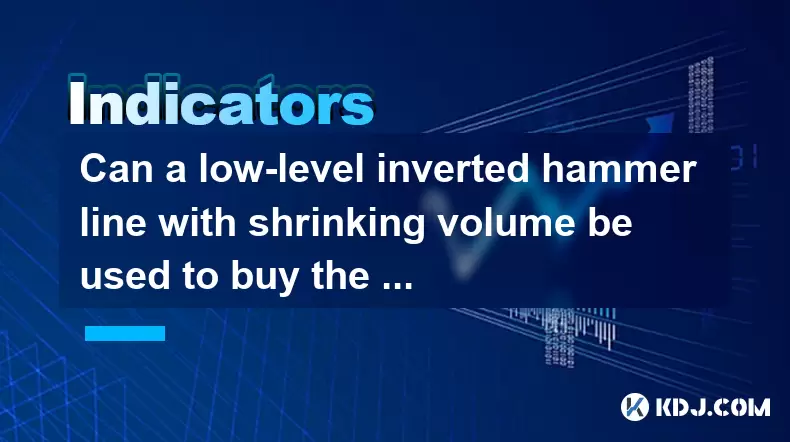
Understanding the Low-Level Inverted Hammer Line
A low-level inverted hammer line is a candlestick pattern that typically appears at the bottom of a downtrend. It consists of a small real body near the top of the trading range with a long upper shadow and little or no lower shadow. This formation suggests that buyers attempted to push prices higher but were met with selling pressure, which eventually pushed prices back down close to the opening level.
The inverted hammer often signals potential bullish reversal when it appears after a sustained decline. However, the presence of this pattern alone is not sufficient to confirm a reversal; traders must look for additional signals such as volume behavior and follow-through price action.
Important: The low-level inverted hammer should be interpreted in context with other technical indicators and market sentiment.
The Role of Shrinking Volume in Candlestick Analysis
Volume plays a crucial role in confirming candlestick patterns. When analyzing the inverted hammer, shrinking volume during its formation may indicate weakening bearish momentum. A decrease in volume implies that sellers are losing conviction, potentially setting the stage for a reversal.
However, shrinking volume can also suggest apathy or lack of interest from both buyers and sellers. Therefore, it's essential to assess whether the volume shrinkage coincides with a reduction in downward momentum or if it's simply a pause in a broader downtrend.
Important: Shrinking volume accompanying an inverted hammer may signal diminishing selling pressure, but confirmation is still required.
How to Confirm the Bullish Signal of an Inverted Hammer
To use the low-level inverted hammer as a potential buy signal, especially with shrinking volume, traders should look for:
- A strong bullish candle following the inverted hammer.
- An increase in volume on the next day or session, suggesting renewed buying interest.
- Support levels aligning with the price zone where the pattern formed.
- Positive divergence in oscillators like RSI or MACD.
Traders should wait for the candle following the inverted hammer to close above the high of the pattern before considering entry. This confirmation step helps filter out false signals and improves trade reliability.
Important: Confirmation through subsequent price action and volume increase is critical before acting on an inverted hammer pattern.
Practical Steps to Trade the Inverted Hammer with Shrinking Volume
Here’s how you can practically approach a low-level inverted hammer with shrinking volume:
- Identify a clear downtrend on your chart (daily or 4-hour timeframe).
- Spot the inverted hammer forming at a key support level or Fibonacci retracement zone.
- Check the volume associated with the pattern — look for contraction compared to previous candles.
- Wait for the next candle to close above the high of the inverted hammer.
- Place a buy order slightly above the high of the inverted hammer.
- Set a stop loss just below the low of the inverted hammer or the recent swing low.
- Monitor volume on the breakout candle — rising volume increases the probability of success.
This strategy works best when combined with other tools like moving averages or trendlines to filter out weak setups.
Important: Entry should only occur after confirmation candle closes above the inverted hammer’s high, accompanied by increasing volume.
Common Pitfalls When Using the Inverted Hammer Pattern
Despite its popularity, many traders fail when using the inverted hammer due to several common mistakes:
- Trading the pattern without waiting for confirmation.
- Ignoring the broader market context and relying solely on the candlestick signal.
- Misinterpreting the volume — sometimes shrinking volume reflects indecision rather than strength.
- Entering too early or placing stops too tight without considering volatility.
- Failing to combine the pattern with other technical tools for confluence.
Avoiding these pitfalls requires discipline, patience, and a structured trading plan.
Important: Never trade the inverted hammer in isolation; always seek confirmation and confluence from other indicators.
Frequently Asked Questions
Q1: Can I use the inverted hammer pattern in crypto scalping strategies?
Yes, but caution is advised. The inverted hammer is more reliable on higher timeframes like 4-hour or daily charts. On lower timeframes, noise and volatility in crypto markets can lead to frequent false signals.
Q2: Should I ignore the inverted hammer if volume doesn’t increase after the pattern?
Not necessarily. Shrinking volume during the inverted hammer may indicate reduced selling pressure, but a lack of volume increase afterward could suggest weak buying interest. Consider using other tools like RSI or order book analysis to validate strength.
Q3: How does the inverted hammer differ from the shooting star?
While both have similar shapes, the inverted hammer appears in a downtrend and signals a potential bullish reversal, whereas the shooting star forms in an uptrend and indicates a bearish reversal.
Q4: Is the inverted hammer reliable in sideways or ranging markets?
It can appear frequently in sideways markets, but its significance diminishes unless it forms near clear support or resistance levels. Always evaluate the inverted hammer within the context of the prevailing market structure.
Disclaimer:info@kdj.com
The information provided is not trading advice. kdj.com does not assume any responsibility for any investments made based on the information provided in this article. Cryptocurrencies are highly volatile and it is highly recommended that you invest with caution after thorough research!
If you believe that the content used on this website infringes your copyright, please contact us immediately (info@kdj.com) and we will delete it promptly.
- OKX and Binance Delist Trading Pairs: What's Going On?
- 2025-07-01 02:30:12
- Pepeto vs. Shiba Inu: Can the New Meme Coin Dethrone the King?
- 2025-07-01 02:50:11
- Meme Coin Mania: Pepeto, Pepe, and Shiba Inu Race to Dominate July 2025
- 2025-07-01 03:50:12
- Saylor, Bitcoin, Holdings: Strategy's Crypto Empire Grows
- 2025-07-01 02:30:12
- Ruvi AI: The Audited Token Set to Outshine Shiba Inu?
- 2025-07-01 03:55:12
- BONK's Double Bottom Dance: Will Critical Support Hold?
- 2025-07-01 04:00:22
Related knowledge
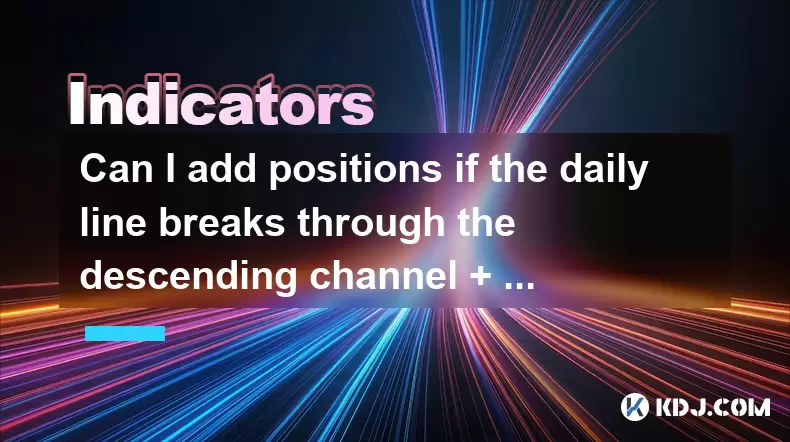
Can I add positions if the daily line breaks through the descending channel + the 30-minute moving average is in a bullish arrangement?
Jun 30,2025 at 11:00pm
Understanding the Descending Channel BreakoutWhen a daily line breaks through a descending channel, it indicates a potential shift in market sentiment from bearish to bullish. A descending channel is formed by drawing two parallel trendlines, where the upper trendline connects the lower highs and the lower trendline connects the lower lows. A breakout o...
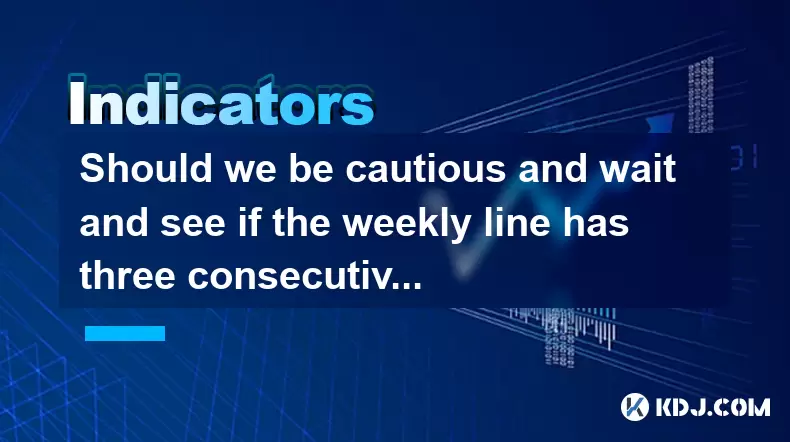
Should we be cautious and wait and see if the weekly line has three consecutive Yin lines + the daily MACD green column enlarges?
Jul 01,2025 at 12:42am
Understanding the Weekly Three Consecutive Yin Lines PatternIn technical analysis, three consecutive Yin lines on a weekly chart indicate a strong bearish trend. Each Yin line represents a week where the closing price is lower than the opening price, signaling consistent selling pressure. When this pattern appears three times in succession, it often sug...
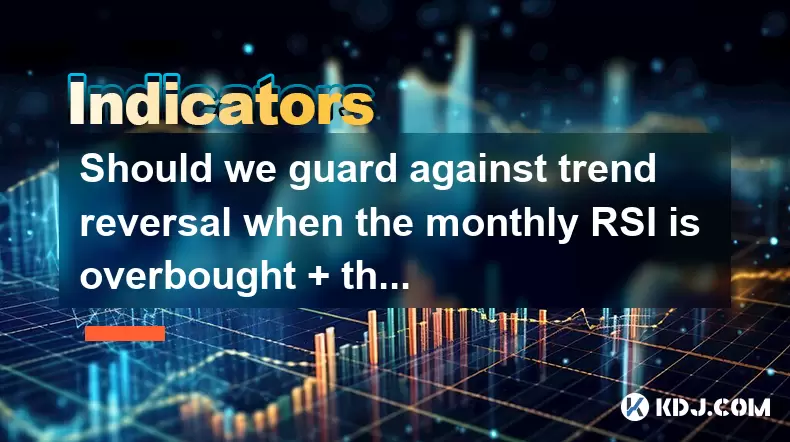
Should we guard against trend reversal when the monthly RSI is overbought + the weekly line has a long upper shadow?
Jun 30,2025 at 11:35pm
Understanding RSI Overbought Conditions in CryptocurrencyThe Relative Strength Index (RSI) is a momentum oscillator commonly used in technical analysis to identify overbought or oversold conditions in an asset. When the monthly RSI of a cryptocurrency reaches above 70, it is generally considered overbought, suggesting that the asset may be due for a pul...
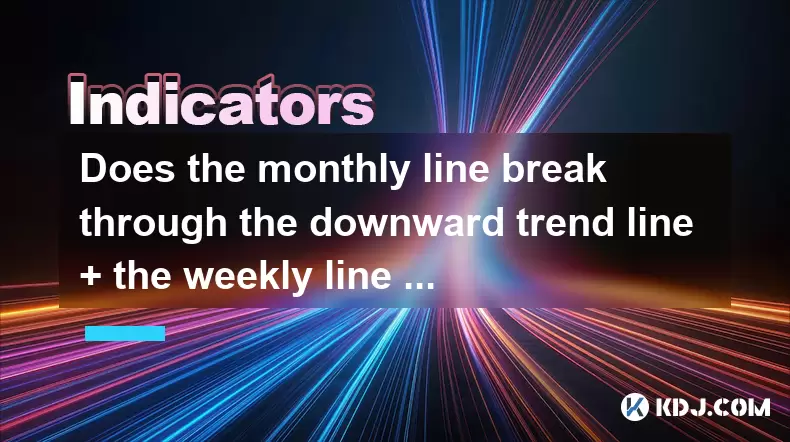
Does the monthly line break through the downward trend line + the weekly line with large volume confirm the reversal?
Jul 01,2025 at 04:49am
Understanding the Monthly Line Breakthrough in CryptocurrencyIn cryptocurrency trading, a monthly line refers to the price movement over a 30-day period represented on a candlestick chart. When this monthly line breaks through a downward trend line, it suggests that the long-term bearish momentum might be weakening. A downward trend line is drawn by con...
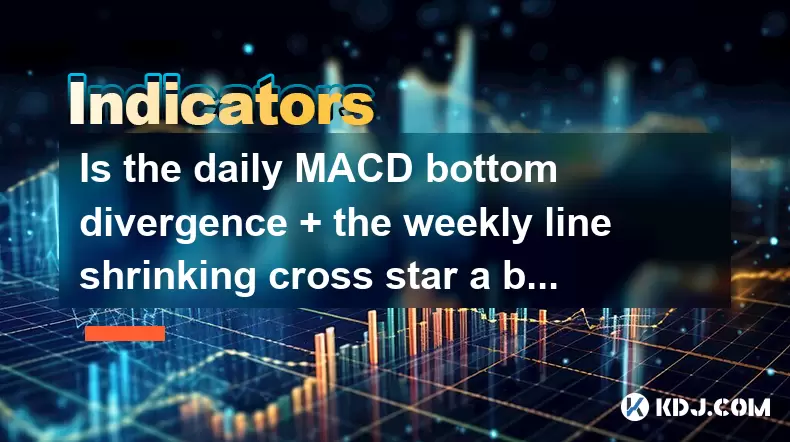
Is the daily MACD bottom divergence + the weekly line shrinking cross star a bottoming signal?
Jul 01,2025 at 03:49am
Understanding MACD Bottom Divergence in Cryptocurrency TradingThe Moving Average Convergence Divergence (MACD) is a widely used technical indicator among cryptocurrency traders to identify potential trend reversals. A bottom divergence occurs when the price of an asset makes a lower low, but the MACD line forms a higher low. This suggests that bearish m...
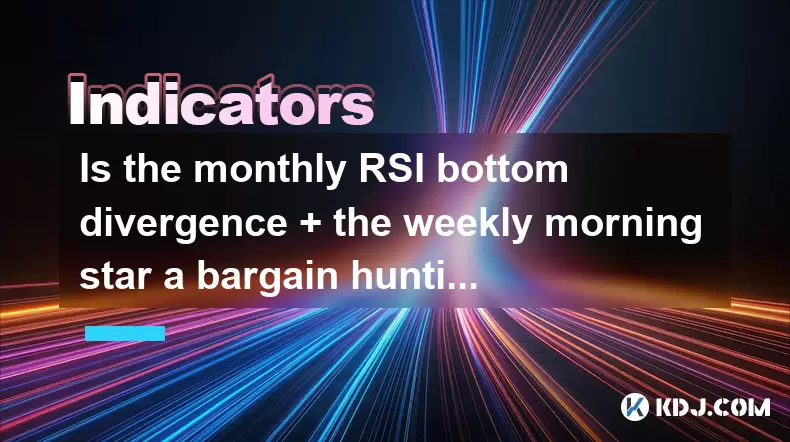
Is the monthly RSI bottom divergence + the weekly morning star a bargain hunting opportunity?
Jun 30,2025 at 09:57pm
Understanding RSI Bottom Divergence in Monthly TimeframesThe Relative Strength Index (RSI) is a momentum oscillator commonly used to identify overbought or oversold conditions in the market. When traders refer to a monthly RSI bottom divergence, they're observing a situation where the price makes a lower low, but the RSI makes a higher low on the monthl...

Can I add positions if the daily line breaks through the descending channel + the 30-minute moving average is in a bullish arrangement?
Jun 30,2025 at 11:00pm
Understanding the Descending Channel BreakoutWhen a daily line breaks through a descending channel, it indicates a potential shift in market sentiment from bearish to bullish. A descending channel is formed by drawing two parallel trendlines, where the upper trendline connects the lower highs and the lower trendline connects the lower lows. A breakout o...

Should we be cautious and wait and see if the weekly line has three consecutive Yin lines + the daily MACD green column enlarges?
Jul 01,2025 at 12:42am
Understanding the Weekly Three Consecutive Yin Lines PatternIn technical analysis, three consecutive Yin lines on a weekly chart indicate a strong bearish trend. Each Yin line represents a week where the closing price is lower than the opening price, signaling consistent selling pressure. When this pattern appears three times in succession, it often sug...

Should we guard against trend reversal when the monthly RSI is overbought + the weekly line has a long upper shadow?
Jun 30,2025 at 11:35pm
Understanding RSI Overbought Conditions in CryptocurrencyThe Relative Strength Index (RSI) is a momentum oscillator commonly used in technical analysis to identify overbought or oversold conditions in an asset. When the monthly RSI of a cryptocurrency reaches above 70, it is generally considered overbought, suggesting that the asset may be due for a pul...

Does the monthly line break through the downward trend line + the weekly line with large volume confirm the reversal?
Jul 01,2025 at 04:49am
Understanding the Monthly Line Breakthrough in CryptocurrencyIn cryptocurrency trading, a monthly line refers to the price movement over a 30-day period represented on a candlestick chart. When this monthly line breaks through a downward trend line, it suggests that the long-term bearish momentum might be weakening. A downward trend line is drawn by con...

Is the daily MACD bottom divergence + the weekly line shrinking cross star a bottoming signal?
Jul 01,2025 at 03:49am
Understanding MACD Bottom Divergence in Cryptocurrency TradingThe Moving Average Convergence Divergence (MACD) is a widely used technical indicator among cryptocurrency traders to identify potential trend reversals. A bottom divergence occurs when the price of an asset makes a lower low, but the MACD line forms a higher low. This suggests that bearish m...

Is the monthly RSI bottom divergence + the weekly morning star a bargain hunting opportunity?
Jun 30,2025 at 09:57pm
Understanding RSI Bottom Divergence in Monthly TimeframesThe Relative Strength Index (RSI) is a momentum oscillator commonly used to identify overbought or oversold conditions in the market. When traders refer to a monthly RSI bottom divergence, they're observing a situation where the price makes a lower low, but the RSI makes a higher low on the monthl...
See all articles

























































































